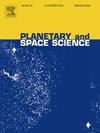碳耗尽彗星C/2023 A3的近日点前观测(Tsuchinshan-ATLAS)。CN生成和分子上限的见解
IF 1.7
4区 物理与天体物理
Q3 ASTRONOMY & ASTROPHYSICS
引用次数: 0
摘要
对彗星分子发射的研究为了解太阳系的原始组成以及形成这些冰体的物理和化学过程提供了至关重要的见解。彗星作为早期太阳系的遗迹,是挥发性化合物的天然档案,可以让我们一窥原行星盘的状况。在这项工作中,我们分析了彗星C/2023 A3 (tsuchinhan - atlas)的光学近日点前光谱,该光谱是由国家伽利略望远镜(TNG)上的DOLORES光谱仪于2024年5月1日获得的。使用IRAF软件包中实施的标准程序减少了彗星光谱。为了表征彗星C/2023 A3的挥发性成分,我们推导了唯一可检测到的分子发射物CN的产率,并计算了未检测到的物种(包括C2、C3和NH2)的上限。考虑到仪器分辨率和观测条件,这些约束条件是通过分析连续区域的噪声水平和整合理论线剖面得到的。我们计算出CN的产率为(3.89±0.21)×1025分子/s。尽管存在明显的尘埃污染,这可能会模糊通常与彗星活动相关的较弱的分子发射线,但我们推导出了关键挥发物质的产率上限:QC3<;3.12×1024分子/s, QC2<;1.30×1025分子/s和QNH2<;2.79×1025分子/s。我们还测定了Afρ参数,得到了4329±56 cm的值,这证实了之前报道的这颗彗星的高尘埃产生率。产率的对数比logQ(C2)/Q(CN)<−0.48表明C/2023 A3是一颗碳耗尽的彗星,与之前对动态新彗星的分类一致。这些发现有助于更深入地了解这些物体的组成多样性和进化过程。本文章由计算机程序翻译,如有差异,请以英文原文为准。
Pre-perihelion observations of the carbon-depleted comet C/2023 A3 (Tsuchinshan-ATLAS). Insights into CN production and molecular upper limits
The study of cometary molecular emissions provides crucial insights into the primordial composition of the Solar System and the physical and chemical processes shaping these icy bodies. Comets, as remnants of the early Solar System, serve as natural archives of volatile compounds that offer a glimpse into the conditions of the protoplanetary disk. In this work, we analyze an optical pre-perihelion spectrum of comet C/2023 A3 (Tsuchinshan-ATLAS), obtained using the DOLORES spectrograph at the Telescopio Nazionale Galileo (TNG) on May 1, 2024. The cometary spectrum was reduced using standard procedures implemented in the IRAF software package. To characterize the volatile inventory of comet C/2023 A3, we derived the production rate of CN, the only detectable molecular emission, and calculated upper limits for undetected species, including C, C, and NH. These constraints were obtained by analyzing the noise level in continuum regions and integrating theoretical line profiles, accounting for instrumental resolution and observational conditions. We calculated a CN production rate of (3.89) molec/s. Despite significant dust contamination, which likely obscures weaker molecular emission lines typically associated with cometary activity, we derived upper limits for the production rates of key volatile species: Q molec/s, Q molec/s, and Q molec/s, respectively. We also determined the parameter, obtaining a value of cm, which confirms the high dust production rate previously reported for this comet. The logarithmic ratio of production rates, , indicates that C/2023 A3 is a carbon-depleted comet, consistent with previous classifications of dynamically new comets. These findings contribute to a deeper understanding of the compositional diversity and evolutionary processes of such objects.
求助全文
通过发布文献求助,成功后即可免费获取论文全文。
去求助
来源期刊

Planetary and Space Science
地学天文-天文与天体物理
CiteScore
5.40
自引率
4.20%
发文量
126
审稿时长
15 weeks
期刊介绍:
Planetary and Space Science publishes original articles as well as short communications (letters). Ground-based and space-borne instrumentation and laboratory simulation of solar system processes are included. The following fields of planetary and solar system research are covered:
• Celestial mechanics, including dynamical evolution of the solar system, gravitational captures and resonances, relativistic effects, tracking and dynamics
• Cosmochemistry and origin, including all aspects of the formation and initial physical and chemical evolution of the solar system
• Terrestrial planets and satellites, including the physics of the interiors, geology and morphology of the surfaces, tectonics, mineralogy and dating
• Outer planets and satellites, including formation and evolution, remote sensing at all wavelengths and in situ measurements
• Planetary atmospheres, including formation and evolution, circulation and meteorology, boundary layers, remote sensing and laboratory simulation
• Planetary magnetospheres and ionospheres, including origin of magnetic fields, magnetospheric plasma and radiation belts, and their interaction with the sun, the solar wind and satellites
• Small bodies, dust and rings, including asteroids, comets and zodiacal light and their interaction with the solar radiation and the solar wind
• Exobiology, including origin of life, detection of planetary ecosystems and pre-biological phenomena in the solar system and laboratory simulations
• Extrasolar systems, including the detection and/or the detectability of exoplanets and planetary systems, their formation and evolution, the physical and chemical properties of the exoplanets
• History of planetary and space research
 求助内容:
求助内容: 应助结果提醒方式:
应助结果提醒方式:


